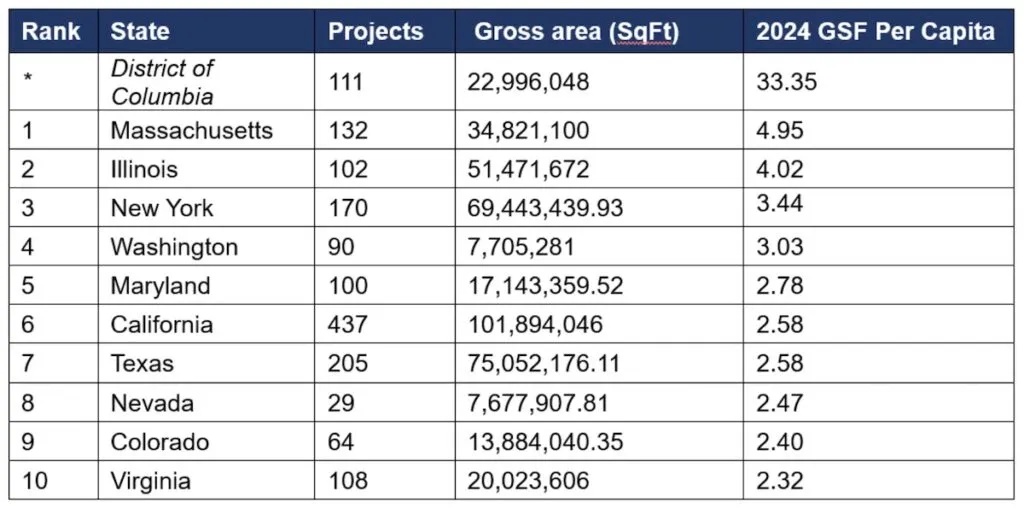
The U.S. Green Building Council (USGBC) has recognized Massachusetts, Illinois, New York, Washington, and Maryland as the top five states for green building in 2024, highlighting their commitment to sustainable practices and the LEED certification program. The USGBC’s annual rankings, which assess each state’s LEED-certified projects and their contributions to sustainable communities, show a significant shift in how states are addressing environmental challenges.

Massachusetts retained its position at the top, thanks to its high LEED-certified square footage per capita. In 2024, the state reached 4.95 LEED-certified square feet per capita, surpassing 34 million square feet across 132 projects. The state has long been a leader in adopting green construction practices, with projects like the Gillette Stadium renovation, which received Gold certification under the LEED v4.1 Operations + Maintenance category. Massachusetts also mandates that all state-owned new constructions and major renovations meet the "LEED Plus" standard, ensuring a commitment to environmentally responsible design.
Following Massachusetts, Illinois, New York, Washington, and Maryland were ranked second through fifth, based on their achievements in green building and LEED certification. Illinois saw 4.017 square feet of certified space per capita, while New York reached 3.438 square feet. Notably, Maryland experienced the most significant improvement in its ranking, climbing five positions from the previous year, driven by a 61% increase in the number of LEED-certified projects.
Although it was not officially part of the state rankings, the District of Columbia continued to lead the nation with more than 33 square feet of certified space per resident, encompassing 111 green building projects. This underscores the District’s ongoing commitment to sustainability, setting a high standard for urban green initiatives.

In total, the top 10 states in 2024 certified 1,437 LEED projects, accounting for over 414 million square feet of space. This reflects the growing demand for sustainable and energy-efficient buildings as communities across the country aim to reduce their environmental footprint.
Peter Templeton, USGBC’s president and CEO, noted, “LEED provides a proven path to meeting these critical priorities,” emphasizing the program’s role in fostering resilient, healthy, and sustainable urban development. The LEED framework has become instrumental in helping governments and private developers alike align their sustainability goals with responsible building practices.
The USGBC is also preparing for the release of LEED v5, the next iteration of the LEED rating system. In 2024, the organization held two public comment periods for LEED v5, receiving over 6,000 comments from global stakeholders. These inputs will be incorporated into the final version of the system, which is expected to be released later this year. The new version will build on the success of LEED v4.1 and address evolving challenges in the green building sector, further enhancing its ability to support sustainability in construction.
As LEED celebrates its 25th anniversary in 2024, the program has become the world's most widely used green building certification system. Since its creation in 2000, LEED has been a key driver in promoting sustainable architecture and urban planning. The LEED certification helps institutions and companies measure their environmental impact, demonstrating their commitment to sustainable growth and development.
USGBC’s celebration of its 25th anniversary also highlights the substantial progress made in the green building movement, particularly as more states and cities adopt LEED standards to create healthier, more resilient communities. As green building practices continue to evolve, the LEED certification system remains a vital tool for transforming the built environment and combating climate change.